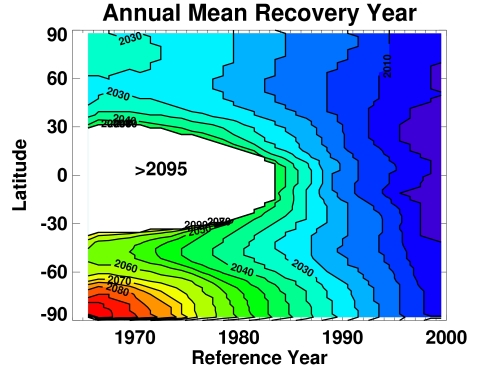Featured Results
Study by John Austin and colleagues on the Ozone recovery date

The figure shows the stratospheric ozone recovery date as a function of
latitude for a baseline column ozone level simulated on a particular
year given on the abscissa. The results were obtained from a range of
coupled chemistry climate models (including the GFDL model AMTRAC3)
which contributed to the Chemistry Climate Model Validation (CCMVal)
project. Ozone recovery is anticipated over about half of the Earth’s
surface. In the northern hemisphere, outside the tropics, ozone recovery
is expected to occur faster than the reduction in ozone depleting
substances due to the effect of climate change. In the southern
hemisphere, column ozone is expected to recover at approximately the
same rate as ozone depleting substances. However, a small residual ozone
hole is still simulated to occur in some models even as late as the end
of the century. In the latitude range 30S-30N, after an initial
recovery, column ozone is expected to continue to decrease slowly from
the middle of the 21st century. This arises from the anticipated
increase in the strength of the circulation which transports low ozone
from the upper troposphere to the lower stratosphere.
List of authors:
J. Austin, H. Struthers, J. Scinocca, D. Plummer, J.F. Lamarque, A.
Gettelman, D. Kinnison, H. Akiyoshi, Y.Yamashita, T. Nakamura,
T.G. Shepherd, M. Michou, H. Teyssedre, M. Dameris, H. Garny,
A.J.G. Baumgaertner, C. Bruhl, P. Jockel, S. Pawson, R. Stolarski,
S. Frith, S. Bekki, K. Shibata, D. Smale, O. Morgenstern, G.E. Bodeker,
E. Rozanov, T. Peter, E. Mancini, G. Pitari, M. Chipperfield, S. Dhomse,
N. Butchart, S. Hardiman, P. Braesicke, J. Pyle


